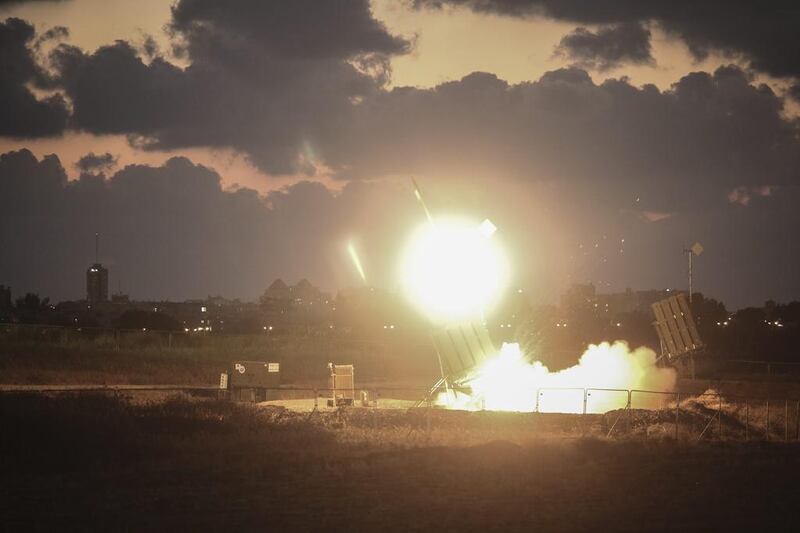GAZA CITY // Rockets fired by militants in Gaza over the past days of fighting have struck deeper into Israel than ever before, causing fear but not mass casualties.
According to Israel’s military and analysts, an increasing number of rockets with ranges longer than 20 kilometres are being produced inside the Hamas-run territory.
Despite these advances, Israel’s missile defence system, the Iron Dome, has intercepted many of them.
This has curtailed Hamas’s ability to threaten Israel and, in turn, its bargaining power during ceasefire negotiations, said Shlomo Brom, a retired Israeli air force brigadier general and a research fellow at Tel Aviv’s Institute for National Security Studies.
“Much of the potential effect of these rockets is neutralised by Iron Dome,” he said. “They could have the potential to have a real impact on Israeli decision-making, but Iron Dome has prevented this.”
Israel’s military said on Wednesday that Iron Dome had a success rate of 86 per cent, intercepting 228 Gaza-fired rockets in the current round of fighting. The system focuses on projectiles fired at cities and ignores rockets that do not threaten population centres.
That, Gen Brom added, has prolonged the fighting because Israeli leaders are not facing the sort of civilian casualties that would pressure them to reach a truce. So far, only one Israeli has been killed.
“The Israeli successes in preventing successes in Hamas rocket fire is making the ceasefire agreement more difficult,” he said. “Israeli officials are not under the sort of pressure that would push them to a quick agreement.”
Still, in terms of weapons advancement, Gaza’s rocket-production industry has grown by leaps and bounds from a decade ago when fighters used crude Qassam rockets that had a range of only four to 15 kilometres.
About 40 per cent of rockets with a range of 20 kilometres or longer are made inside the territory, according to IHS Jane’s Defence Weekly, citing Israeli military statistics. The rest are believed to have been brought in by sea and through a now largely destroyed network of tunnels from Egypt.
The report said that one of the new locally produced projectiles is the M-302, a variation of the Syrian-made version with a potential range of 200 kilometres. One of those projectiles struck Hadera, an Israeli city about 116 kilometres north of Gaza, on July 8.
Another locally produced rocket is the J-80, named after Ahmed Jabari, the Hamas military chief whose assassination in November 2012 triggered an eight-day war with Israel. Hamas said it debuted the J-80 on Saturday when it launched a barrage of rockets at Tel Aviv that was largely neutralised by Iron Dome interceptors.
Some estimates say Hamas had 10,000 rockets before the 2012 war and still possesses thousands.
More than 1,200 have been fired from Gaza since the current fighting began on July 8, according to the Israeli army.
The 2012 war included the use of “Iranian-made Fajr-5 missiles with a range of 75 kilometres and Gaza-built M75 rockets with a range of 80 kilometres”, said the Jane’s report, which was released earlier this week.
The advances in local production has enabled Hamas to continue using rockets despite Israel’s tightened and Egypt-backed siege of Gaza.
Under the military-backed leadership installed last summer, Egypt systematically destroyed the tunnels dug from Gaza that provided the territory not only with cheap food and fuel, but also weapons.
“The local production has increased dramatically over the years and it serves Hamas well given the siege,” said Zakaria Al Qaq, a professor of security studies Jerusalem’s Quds University.
That progress has also helped free Hamas from relying on rockets from allies such Iran and Syria, which have reduced support to the Islamist group over its decision to back the rebellion against the Syrian president Bashar Al Assad.
Because of a lack of machinery and chemicals, locally produced weapons may not be as accurate as those made in professional arms-production facilities, said Mr Al Qaq. But Hamas and allied groups are gradually perfecting the weapons in their arsenal, potentially increasing their payloads as well.
“If they could make these weapons lethal and deliver them, then that would seriously up the threat on Israel and change the game,” he said.
hnaylor@thenational.ae





